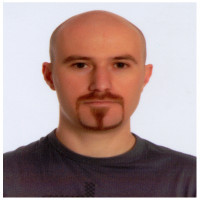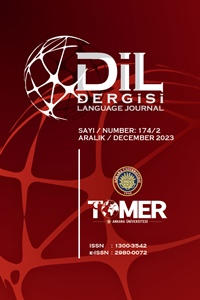Research Article
Issue Editorial Board


Aytaç Çeltek is an associate professor in linguistics at Kırıkkale University, Türkiye. Her research mainly focuses on the reference system in Turkish discourse, second language teaching and learning of Turkish, and the linguistic repertoire of the bilingual (Greek and Turkish) community of Rhodes. She is recently interested in projects using parallel corpora in translation studies investigating how discursive factors are conveyed in translation between Turkish-English language pair.


Aim & Scope
Dil Dergisi is a double blind peer-reviewed international journal that began its publication in 1988. The journal provides a platform for different theoretical and thematic approaches to linguistics and language teaching. We accept only manuscripts written in Turkish and English.
The editors seek manuscripts that:
• develop theoretical, conceptual, or methodological approaches to language and linguistics,
• present results of empirical research that advance the understanding of language and linguistics,
• explore innovative policies and programs and describe and evaluate strategies for future action, and
• analyze issues of current interest.
Author Guidelines
All material to be considered for publication in the Dil Dergisi, before submission and blind review, should be prepared in accordance with the instructions below:
- Manuscripts should be in Turkish or in English.
- Manuscripts sent to the journal should not have been previously published elsewhere and should not have been sent to another journal for publication.
- Manuscripts not prepared in accordance with the journal’s style guide are not considered for publication.
- Manuscripts sent to the journal should comply with the following: a) All manuscripts should be typed on a standard A4 vertical size word document in single space format with margins of 2.5 cm on all sides. b) Manuscripts should be no less than 4000 and no more than 10000 words in length, excluding the abstract and references pages. The text should be written in Bookman Old Style 11 point font with 1.5 line spacing on Microsoft Word.
Manuscripts should include the following parts in the order as stated below, and should be structured according to the following instructions:
- Title: The title of the manuscript should be centered and written in UPPERCASE with 12 point font, bold type. The title should not exceed 2 lines excluding numbers and punctuation marks.
- Title in Turkish: The title in Turkish, placed after the English title, should be centered and the first letter of each word should be written in 10 point font, bold and italic type.
- Author / Authors: The title should be followed by the author’s name (in lowercase with the first letter capitalized) and last name (in UPPERCASE LETTERS) which should be right-aligned and written in 12 point font, bold type. This should be followed by information about the author (academic position, institution and author's email address) should be given. Also, the photograph of the author(s) should be uploaded on the system.
- Abstract (in English): The abstract in English should be single-spaced and written in 10 point font italic type with the first letter of each word capitalized. The abstract should not exceed 300 words.
- Keywords (in English): A minimum of 4 and a maximum of 8 keywords in English which identify the content of the work should be presented. The first letter of each keyword should be capitalized, and each keyword must be separated by a semicolon and written in italic type.
- Öz (Abstract in Turkish): The text given in the English abstract should be written in Turkish in italic.
- Anahtar Sözcükler (Keywords in Turkish): Manuscripts should also present a minimum of 4 and a maximum of 8 keywords (identifying the content of the work) in Turkish. The first letter of each keyword should be capitalized and written in italic type. Turkish keywords (Anahtar Sözcükler in Turkish) should be given in the same order and should mean the same as the words given in the English keywords.
For Applied Research:
- Introduction: The basis of the research subject, summary of the parts of the study, its relevance to academic body of literature, significance of the study, research problem and its goals should be discussed in detail in the introductory part. This part can be structured under a single title or several subheadings. No bold or underlined phrases should be used in the text.
- Method: The type, model, questions and hypotheses, research population, data collection techniques, validity and reliability, data analysis, limits of the study, and ethics committee approval (if necessary) should be included in the methods part. This part can be structured in subheadings like Research Problems, Research Model, Hypotheses, Data Analysis, and
Data Collection Techniques.
- Results: The results of the study should be explained to support the goal and problem of the study, and should be explored through related tables, figures, graphs, or diagrams in a way to preserve the integrity of the study. All the tables, figures, graphs, or diagrams used in the study should be clearly signposted by in-text directions. The results in the form of graphs or figures should be presented in high-quality in order to ensure publication quality and legibility. Findings demonstrated in tables should be presented in a format in accordance with the APA Guidelines. All the tables, graphs, figures, and diagrams used in the study should be titled. The results can be presented under subheadings in order to increase the legibility and clarity of the study.
- Conclusion: Conclusion(s) reached in the light of the findings of the study should be explained.
- Suggestions: In line with the conclusion(s) of the study, suggestions should be developed. These suggestions should also point to potential future studies and practices in the field which will contribute to the relevant academic body of literature.
- Acknowledgements: Individuals or institutions that contributed to the study (if necessary) should be acknowledged in the form of footnotes.
Ethical Principles and Publication Policy
Peer Review Process
• Peer review is the evaluation of manuscripts submitted to Dil Dergisi by experts in related fields.
• Peer–review enables authors to receive critical feedback from experts on individual manuscripts.
• Reviewers evaluate the submitted manuscripts in an objective manner. They express their opinions clearly and support their comments.
• All submitted manuscript is kept confidential. Reviewers are not allowed to share or disclose unpublished information in a manuscript.
• Reviewers of Dil Dergisi avoid evaluating manuscripts in which they have conflicts of interest. They contact editors if there is any conflict of interest that could affect their evaluation of a manuscript. In those cases, they can reject reviewing the manuscript.
• Reviewers can recommend to author/s any related work that is not cited.
Recruitment for Reviewers
Participation in the peer-review process is absolutely essential to the success and reputation of the journal. Reviewers and editors determine which works are of quality and significance. Due to our extensive readership, the research and scholarship selected by our reviewers will ultimately have an impact on literacy in national and international classrooms.
If you are interested in becoming a reviewer for Dil Dergisi, please contact us at makaroglu@ankara.edu.tr
Publication Frequency
Dil Dergisi is published twice a year, in June and December.
Open Access Policy
This journal provides immediate open access to its content on the principle that making research freely available to the public supports a greater global exchange of knowledge.
Archiving Policy
Dil Dergisi employs the LOCKSS system through DergiPark (A service provided by Scientific and Technological Research Council of Turkey -TUBITAK) to create a distributed archiving system to create permanent archives of the journal for the aims of preservation and restoration.
For more information about LOCKSS system please visit LOCKSS
Indexing & Abstracting
• MLA International Bibliography
• TRDizin
• Central and Eastern European Online Library (CEEOL)
• BRILL Linguistic Bibliography
• SOBİAD Indexing
• Ulrich's (Ulrichs Web Global Serials Director)
Advisory Board
In Alphabetical Order
Ayşe Kıran (Hacettepe University)
Ayşe Sumru Özsoy (Boğaziçi University)
Belma Haznedar (Boğaziçi University)
Fatma Hülya Özcan (Anadolu Üniversity)
Hatice Sofu (Çukurova University)
İlknur Keçik (Anadolu University)
Kamil İşeri (Dokuz Eylül University)
Kutlay Yağmur (Tilburg University)
Mustafa Aksan (Toros University)
Nalan Büyükkantarcıoğlu (Çankaya University)
Nermin Yazıcı (Hacettepe University)
Nevin Özkan (Ankara University)
Ümit Deniz Turan (Anadolu University)
Yeşim Aksan (Toros University)
Publication ethics
Dil Dergisi is committed to the highest ethical standards. We encourage authors to refer to the Committee on Publication Ethics’ (COPE), International Standards for Authors (https://publicationethics.org/resources/international-standards-for-editors-and-authors). If you have any questions or concerns about an ethical issue, please contact the Journal Editor-in-Chief at makaroglu@ankara.edu.tr
Authors’ Responsibilities
Before submitting an article, authors should ensure that they satisfy the following criteria.
• Authors must claim, that the submission has not been previously published, nor is it before another journal for consideration (or an explanation has been provided in Comments to the Editor). If authors decide to submit their manuscript to another journal, they must withdraw their paper from Dil Dergisi.
• The corresponding author will ensure that all contributing co-authors have approved the final version of the manuscript and agreed to its submission for publication. Only authors who have made a significant contribution to the submitted study will be included.
• Authors must ensure that their manuscript is original and provide a list of references for the material that is taken from other sources.
• Authors must acknowledge their funding for the submitted manuscript. They must state all sources of financial support they received and the role of the funder.
• Authors must carefully read the copyright statement and accept responsibility for releasing necessary information during the submission process.
• Authors should ensure that their data belong to them. If authors do not own the data, they must state that they have permission to use it.
• Authors should ensure that they conform to all research ethics guidelines, especially if human or animal subjects are involved in their research. They should ensure that they obtained proof of consent from participants in their research.
• Authors must state any potential conflict of interest on submission of their manuscript.
• Authors are obliged to participate in a peer review process of their submitted manuscript. They should respond to all the comments and any recommendations of reviewers before the given deadline.
• All contributing authors have a responsibility to inform the Editor of Dil Dergisi immediately, if any error or mistake occurs after the submission of a manuscript or after the publication of a manuscript.
• The Copyright Transfer Form should be signed and sent with the paper submission.
• An ethics committee approval must be obtained for research conducted in all disciplines including social sciences and for clinical and experimental studies on humans and animals, requiring ethical committee decision, and this approval should be stated and documented in the article.
• The articles that are written according to the rules must be submitted online via https://dergipark.org.tr/tr/pub/dilder.Reviewers’ Responsibilities
• Reviewers should keep the review process confidential.
• Reviewers should inform the Journal Editor, if they suspect any potential competing interest.
• Reviewers should evaluate all manuscripts objectively and professionally during the review process.
Editors’ Responsibilities
• Editors should ensure that the manuscripts conform to the ethical policies of their journal.
• Editors should not discriminate against authors on the basis of gender, race, color, religion, national origin, and sexual orientation.
• Editors should address authors’ complaints and keep any documents related with the complaints.
• Editors should ensure that the manuscripts are reviewed in a confidential manner.
• Editors should ensure that authors and reviewers are properly advised regarding the review process as well as publication ethics and policies.
• Editors will handle any misconduct that occurs during the submission process. If Editors become aware of that research misconduct or the use of fraudulent data has occurred, studies will not be eligible for publication. Editors will not encourage such misconduct. Editors will issue a retraction notice, if there is any evidence that the findings are unreliable due to error or misconduct; if the manuscript has been published elsewhere without any permission; if the manuscript involves plagiarism, and if the manuscript involves unethical research.
• Editors will request a correction, if a contributing author is omitted or an author who has not contributed to the manuscript is included in the author list. If an error or mistake is identified in a manuscript, corrections will be made immediately after Editors and all authors agree on the corrections. When necessary, Editors welcome and publish any retractions, corrections, and clarifications submitted by the authors.
Plagiarism Policy
Every manuscript submitted for publication in Dil Dergisi will be checked for plagiarism using the Turnitin program. If plagiarism is detected by the editors or peer reviewers, the editor will inform the author/s immediately, asking the author/s to rewrite the text or provide any necessary citations. If the author/s has plagiarised at least more than 15% of the original source, the manuscript will not be eligible for review and publication.
Copyright and Access
• The author accepts that the publisher of Dil Dergisi holds and retains the copyright of the published articles.
• It is the author’s responsibility to obtain permission to include images, figures, etc. to appear in the article.
*This statement is prepared on the basis of publication ethics and malpractice statement provided on Journal of Language and Linguistic Studies website.
Price Policy
There is no submission and/or publication fee for the manuscripts published in Dil Dergisi. As the publication language of the journal is in Turkish and English, the authors of the manuscripts that have been accepted to publish must have their manuscripts proofread after all editorial, and peer review processes have been completed.







